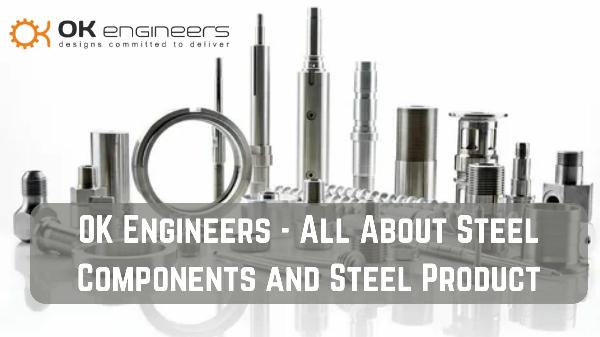It's All About Steel Components | OK Engineers | Blog

Strong 8k brings an ultra-HD IPTV experience to your living room and your pocket.
Steel, an alloy primarily composed of iron and carbon, has been a cornerstone of industrial development for centuries. Its versatility, strength, and durability have made it indispensable in numerous applications, from construction and infrastructure to manufacturing and transportation. This blog delves into the myriad uses of Steel Components, highlighting their significance and the expertise of OK Engineers in producing high-quality steel parts.
The Versatility of Steel Components
Steel Components are ubiquitous in modern life, owing to their remarkable properties. The alloy's ability to withstand high stress, its ductility, and its resistance to wear and corrosion make it ideal for a wide range of applications. These components are essential in sectors such as automotive, aerospace, construction, and energy, demonstrating steel's unparalleled versatility.
1. Automotive Industry
In the automotive industry, Steel Components are crucial for ensuring the safety, performance, and durability of vehicles. Steel is used extensively in the manufacturing of car bodies, chassis, and various engine parts. Its high strength-to-weight ratio is essential for creating lightweight yet robust vehicles, which improves fuel efficiency and reduces emissions.
Car Bodies and Frames: The use of high-strength steel in car bodies and frames enhances crash resistance, providing better protection to occupants during collisions. Modern cars often incorporate advanced high-strength steels (AHSS) that offer superior performance without compromising weight.
Engine Components: Steel's ability to withstand high temperatures and pressures makes it ideal for engine components such as crankshafts, camshafts, and connecting rods. These parts must endure extreme conditions, and steel's durability ensures reliable performance over the vehicle's lifespan.
2. Construction and Infrastructure
Steel Components are the backbone of modern construction and infrastructure. Their strength, durability, and versatility make them indispensable in building skyscrapers, bridges, tunnels, and other structures. Steel's adaptability allows for innovative architectural designs and ensures the longevity of infrastructure projects.
Structural Beams and Columns: Steel beams and columns provide the structural integrity needed for tall buildings and large spans. They can bear heavy loads and resist bending and deformation, making them ideal for constructing resilient structures.
Reinforcement Bars (Rebars): Used in concrete structures, steel rebars enhance the tensile strength of concrete, which is naturally strong in compression but weak in tension. This combination results in reinforced concrete that can withstand various stresses, contributing to the durability of buildings and bridges.
3. Aerospace Industry
The aerospace industry demands materials that offer high strength, low weight, and excellent resistance to extreme temperatures and environmental conditions. Steel Components meet these requirements, playing a vital role in aircraft manufacturing and aerospace engineering.
Landing Gear: The landing gear of an aircraft must endure significant stresses during takeoff, landing, and taxiing. High-strength steel is used to manufacture landing gear components, ensuring they can handle these extreme conditions while maintaining structural integrity.
Aircraft Fasteners: Steel is also used in the production of various fasteners, including bolts, nuts, and screws. These fasteners must securely hold together different parts of the aircraft, withstanding vibrations and dynamic loads during flight.
4. Energy Sector
In the energy sector, Steel Components are essential for the exploration, extraction, and distribution of oil and gas, as well as the generation and transmission of electricity. The durability and strength of steel ensure the safe and efficient operation of energy infrastructure.
Pipelines: Steel pipelines are crucial for transporting oil, gas, and other fluids over long distances. Their resistance to corrosion and ability to withstand high pressures make them ideal for this purpose, ensuring the safe delivery of energy resources.
Wind Turbines: The construction of wind turbines relies heavily on steel for both the tower and the internal components. Steel's strength and durability are vital for withstanding the dynamic loads and harsh environmental conditions that wind turbines encounter.
5. Manufacturing and Machinery
The manufacturing sector benefits significantly from the use of Steel Components in machinery and equipment. Steel's mechanical properties and ease of fabrication make it ideal for producing durable and reliable machinery parts.
Industrial Machinery: Steel is used in the production of various industrial machinery components, such as gears, shafts, and bearings. These parts must endure high loads, friction, and wear, and steel's properties ensure their longevity and performance.
Tooling and Molds: The production of tools and molds for manufacturing processes often involves the use of steel. Its hardness and wear resistance are essential for creating precise and durable tools that can withstand repetitive use.
The Expertise of OK Engineers in Steel Components
OK Engineers has established itself as a leader in the production of high-quality Steel Components. With decades of experience and a commitment to excellence, OK Engineers ensures that every component meets stringent quality standards and delivers superior performance. Their expertise spans various industries, providing tailored solutions that meet the unique demands of each sector.
Precision Manufacturing: OK Engineers employs advanced manufacturing techniques to produce steel components with exceptional precision. Their state-of-the-art facilities and skilled workforce ensure that each part meets exacting specifications, resulting in reliable and high-performance components.
Quality Assurance: Quality is paramount at OK Engineers. Rigorous quality control processes are in place to ensure that every component undergoes thorough testing and inspection. This commitment to quality guarantees that customers receive components that meet or exceed their expectations.
Innovative Solutions: OK Engineers continuously invests in research and development to stay at the forefront of innovation. Their ability to adapt to changing industry needs and incorporate the latest technologies ensures that they can provide cutting-edge solutions to their clients.
Environmental Considerations
The environmental impact of steel production and use is a significant consideration in today's world. Steel is a recyclable material, and the industry has made strides in improving the sustainability of its production processes. Recycling steel reduces the need for raw materials, conserves energy, and minimizes environmental impact.
Recycling Steel: The recycling of steel is a well-established process that reduces waste and conserves resources. Recycled steel can be used to produce new components, reducing the demand for virgin materials and lowering the overall environmental footprint.
Energy Efficiency: Advances in steel production technology have led to more energy-efficient processes. These improvements help reduce greenhouse gas emissions and lower the environmental impact of steel manufacturing.
The Future of Steel Components
The future of Steel Components is promising, with ongoing advancements in materials science and manufacturing technologies. These developments will continue to enhance the performance, durability, and sustainability of steel parts, ensuring their relevance in various industries.
Advanced High-Strength Steels (AHSS): The development of AHSS has opened new possibilities for steel components, particularly in the automotive and aerospace industries. These steels offer higher strength and better formability, allowing for the creation of lighter and more efficient components.
3D Printing and Additive Manufacturing: The adoption of 3D printing and additive manufacturing techniques in steel component production is set to revolutionize the industry. These technologies enable the creation of complex shapes and custom components with high precision and minimal material waste.
Conclusion
Steel Components are integral to the functioning of modern society, playing a crucial role in various industries. From automotive and aerospace to construction and energy, their versatility and durability make them indispensable. OK Engineers' expertise in producing high-quality steel parts ensures that their clients receive components that meet the highest standards of performance and reliability. As technology continues to advance, the importance of steel components will only grow, driving innovation and progress across multiple sectors.
Note: IndiBlogHub features both user-submitted and editorial content. We do not verify third-party contributions. Read our Disclaimer and Privacy Policyfor details.




